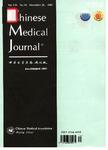Effects of unpredictable chronic stress on behavior and brainderived neurotrophic factor expression in CA3 subfield and dentate gyrus of the hippocampus in different aged rats
Effects of unpredictable chronic stress on behavior and brainderived neurotrophic factor expression in CA3 subfield and dentate gyrus of the hippocampus in different aged rats作者机构:Institute of Medical Psychology School of Medicine Shandong University Jinan Shandong 250012 China Chinese Peop'le's Public Security University Beijing 100038 China Qingdao Women and Children's Medical Center Qingdao Shandong 266011 China
出 版 物:《Chinese Medical Journal》 (中华医学杂志(英文版))
年 卷 期:2009年第122卷第13期
页 面:1564-1569页
核心收录:
学科分类:0710[理学-生物学] 1002[医学-临床医学] 07[理学] 071006[理学-神经生物学] 100214[医学-肿瘤学] 10[医学]
主 题:stress age brain-derived neurotrophic factor hippocampus
摘 要:Background Brain-derived neurotrophic factor (BDNF) is a stress-responsive intercellular messenger modifying hypothalamic-pituitary-adrenal (HPA) axis activity. The interaction between stress and age in BDNF expression is currently not fully understood. This study was conducted to observe unpredictable stress effect on behavior and BDNF expression in CA3 subfield (CA3) and dentate gyrus of hippocampus in different aged rats. Methods Forty-eight Wistar rats of two different ages (2 months and 15 months) were randomly assigned to six groups: two control groups and four stress groups. The rats in the stress group received three weeks of unpredictable mild stress. The depression state and the stress level of the animals were determined by sucrose preference test and observation of exploratory behavior in an open field (OF) test. The expressions of BDNF in CA3 and dentate gyrus of the hippocampus were measured using immunohistochemistry. Results Age and stress had different effects on the behavior of different aged animals (age: F=6.173, P〈0.05, stress: F=6.056, P 〈0.05). Stress was the main factor affecting sucrose preference (F=123.608, P 〈0.05). Decreased sucrose preference and suppressed behavior emerged directly following stress, lasting to at least the eighth day after stress in young animals (P 〈0.05). The older stress rats showed a lower sucrose preference than young stress rats (P 〈0.05). Older control rats behaved differently from the younger control animals in the OF test, spending more time in the central square (P 〈0.05), exhibiting fewer vertical movements (P 〈0.05) and less grooming (P 〈0.05). Following exposure to stress, older-aged rats showed no obvious changes in vertical movement and grooming. This indicates that aged rats were in an unexcited state before the stress period, and responded less to stressful stimuli than younger rats. There was significantly lower BDNF expression in the CA3 and dentate gyrus regions of the hippocampus following stress i



